
The design or repair of any interior space begins with the visualization of the result. At the beginning of such a process, you already have an idea of how the result will ideally appear. At this stage, you should already have a conceptualization of the colors, textures, the arrangement of furniture, appliances, and decor elements. The design or repair of any space begins with the conceptualization of the finishing. The materials for decorating the walls, ceiling, and floor must be carefully thought out in advance. It is important to evaluate the pros and cons of each option and focus on the one that suits you the most. This process is especially important since if the result is unsatisfactory you will have to rework the finishing, a process that is both expensive and time-consuming. Therefore, you need to think carefully before you choose from the wide selection of finishing materials available today.
Types of ceiling surfaces
Often, the process of decorating the home begins with the ceiling. Only a few years ago, the decoration of the ceiling was limited to whitewashing, painting (mainly in light colors), or the use of wallpaper. Today, however, the range of options for decorating the ceiling has surged dramatically. Modern designers are more open-minded about experimenting with the design of the ceiling and offer several bold and original ideas.
Currently, the most popular ceiling decorations are:
- Faux plasterboard ceilings;
- Stretch ceilings;
- All kinds of paint-colored ceilings;
- Original decorative plaster;
- Wallpaper;
- Various ceiling panels;
- A combination of one or more of the above finishing.
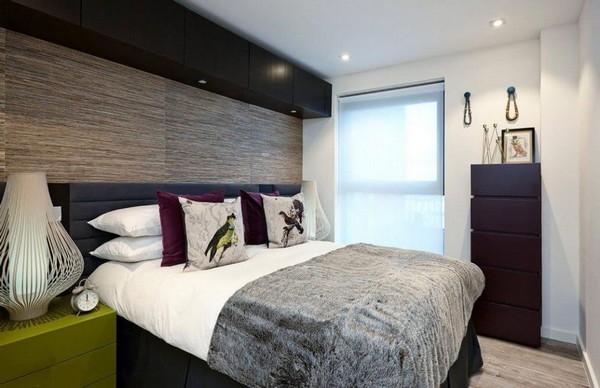
The following sections will discuss the above finishing and décor in detail.
One of the finishing materials, drywall, emerged just a few years ago but quickly gained popularity among designers and homeowners. The composition of a drywall ceiling is quite simple; suspended surfaces are made of high-quality gypsum, which, in turn, has a two-sided cardboard lining. With this solution, you can easily create a unique ceiling design for your home.
In addition, plasterboard ceilings have many more important advantages, including:
- Can be installed even on untreated and non-plastered surfaces. Therefore, it is not necessary to prepare the ceiling for the installation of drywall.
- Plasterboard/drywall can conceal all kinds of cords and pipes located on the ceiling.
- The result of the finishing is a flat and smooth surface devoid of any flaws, which is difficult to achieve with an ordinary whitewash.
- Drywall comprises non-combustible materials, and, therefore it is not flammable and safe with respect to fire.
- Modern technologies use special excipients to ensure the absolute waterproofness of the coating.
- Environmental friendliness: The materials used to create drywall are absolutely safe to both human health and the environment. Therefore, you can safely install a drywall ceiling even in children’s rooms.
- Allows for experimentation: For instance, with the help of gypsum boards, you can create multi-level ceilings, or decorate niches and arches, thereby adding exclusivity to your room.
- This option is suitable for those who plan to install built-in lighting in the room. You can mount bulbs inside the panels while hiding the wiring under the plates.
- In most cases, the installation of drywall is so simple and convenient that you can handle it yourself, without the help of professionals.
- Drywall can easily be combined with other types of materials for ceiling surfaces.
- Affordably priced and available in a fairly wide range of shades.
However, it should be noted that there are several drawbacks to drywall/plasterboard ceiling panels. For example, despite its water-repellent nature, drywall is still not recommended for installation in rooms with high humidity. Therefore, drywall is unsuitable for decorating a kitchen, bathroom, or laundry room. Another disadvantage of the material is its fragility. Drywall is unable to withstand heavy loads and can easily be deformed from mechanical damage.
Another common type of ceiling design is a stretch ceiling. This ceiling design comes in two varieties, one made from fabric and another from a special film. However, either type gives a flat surface.
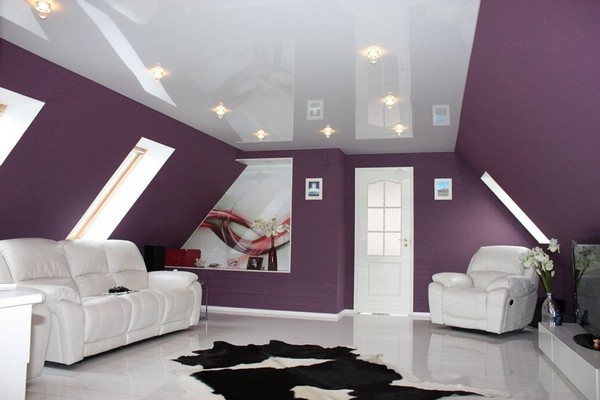
Stretch ceilings have numerous advantages, such as:
- It allows you to conceal wires and pipes;
- Stretch ceilings make it possible to achieve smoothness and symmetry even on uneven surfaces;
- It is waterproof;
- Stretch ceilings can withstand bigger loads than drywall, which can be useful especially in apartments;
- The eco-friendly nature of the material allows it to be used safely in residential spaces;
- Stretch ceilings can be installed quickly and easily. In addition, a stretch ceiling does not gather much dirt or dust, making its maintenance easy;
- They come in a wide range, from a variety of shades to multiple patterns;
- Affordable.
However, despite its many advantages, a stretch ceiling also has limitations. For example, while its installation can be done quickly and easily, you still need to recruit an expert, particularly since the installation of the ceiling requires special equipment. In addition, due to the components of a stretch ceiling, after installation, a discomforting smell may linger in the room for several days.
Wallpaper, on the other hand, was quite popular in decorating the ceiling for several years. However, only light colors were preferred then. Today, you can find more varied ceiling wallpaper, with multiple colors and textures. You can choose either light pastel colors or bolder bright ones.
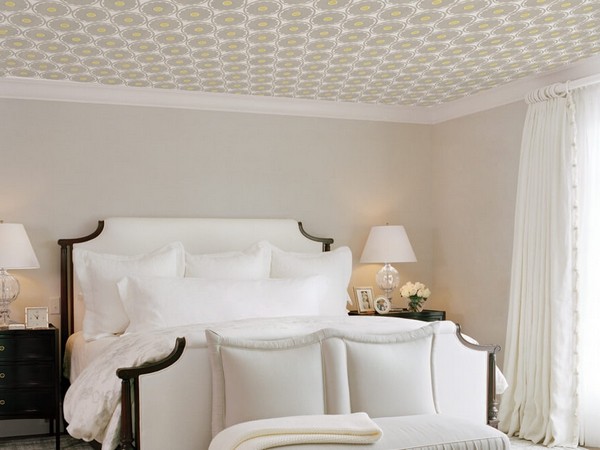
The benefits of ceiling wallpaper include:
- Available in a wide range of colors and patterns.
- You can combine two different wallpapers in a single room.
- Some models can be repainted, thereby making it easy to remodel the room.
- Easy to install: Although wallpapering requires some skill, with sufficient practice, you can easily install it on your own.
- Affordable pricing for good quality.
- Some types are water-resistant.
However, a wallpapered ceiling is not a one-fits-all solution. For instance, rooms facing the sun should know that the wallpaper fades and degenerates with time, due to exposure to heat. In addition, some types of wallpaper are easily damaged by water.
Along with wallpapering, painting the ceiling is a commonly used solution. This decoration method is also quite traditional. However, there are now many more paint colors to choose from. Painting can, however, be difficult in cases where the ceiling surface is uneven. Paint only comes out beautifully on a perfectly aligned surface. Otherwise, the result will be ugly. Therefore, make sure you even the floor before painting it.
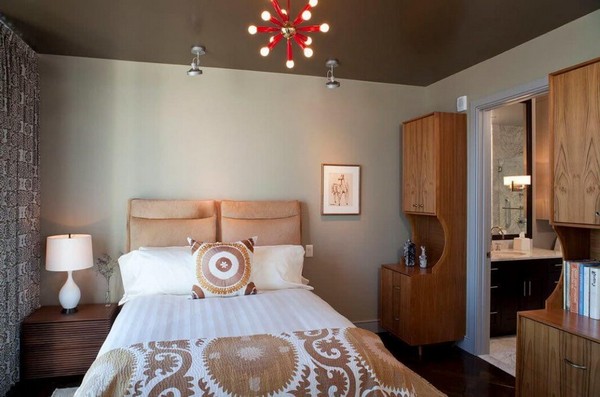
Other methods of decorating the ceiling include the use of special panels, a method that has become particularly trendy in recent years. These wood panels are so easy to install that you can even mount them yourself. While the most popular panels are made from natural wood, there also exist variants made from fiberboard, particleboard, plastic or even glass. However, the variants made from natural materials are preferable, although they are more expensive than the others. Regardless, compared to the previous options, such a ceiling finish, depending on the material chosen, can save you money.
New and emerging trends in wall decor
The appearance of the walls is perhaps the first thing that catches the eye as soon as someone enters a room. Therefore, it is critical that you choose a design that fully syncs with the overall style of the room and emphasizes the beauty of the interior. With the help of the right shade of the walls, you can visually enlarge a small space. In some cases, bright colors are more appropriate since they serve as a highlight of the room.
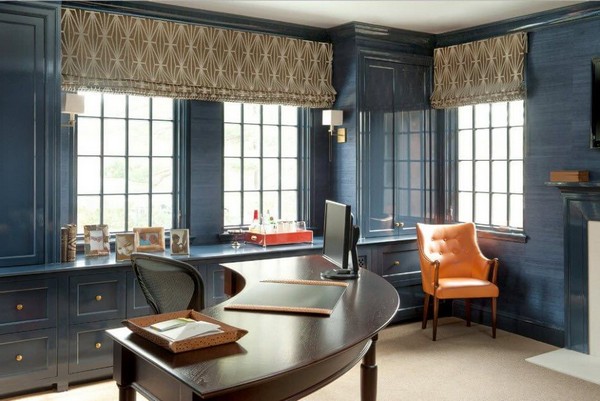
The decoration of the walls does not follow any clearly set out rules. You can choose a neutral, one-color, or patterned solution, for instance, as long as your selected color syncs beautifully with other elements of the space. Color aside, planning and designing walls is not that easy. First, you need to go over several materials and choose one, having considered the pros and cons of each material. For the most part, the design of walls is similar to that of the ceiling, and you can choose from options such as drywall, wallpaper, paint, or a combination of these materials.
While many materials used to decorate walls emerged as fashionable trends, beautiful and stylish wallpaper is a classic design. The wide varieties available today make it easy to choose a suitable variant.
Wallpaper with large patterns is especially beautiful. Still, you need to make your choice carefully. The best solution is to place the wallpaper on one so-called accent wall, since wallpapers with patterns, especially large patterns, can visually reduce the area of the room. However, if you have a large space, you can go ahead and experiment. Wallpapers with large patterns look luxurious and emphasize the elegance of your home. Regardless, you need to remember one important rule; if the wallpaper you have chosen has a large or bright pattern, the furniture should be in a neutral and plain color scheme.
Monophonic wallpaper does not have to look boring and unoriginal. You can spruce up a monophonic wallpaper with the aid of various wall stickers, moldings or even textiles. For a small room, you can just brighten the monophonic wallpaper by hanging small photograph frames or posters on the wall.
The concept of an accent wall has already been discussed in the earlier sections of this article. A similar option as the accent wall is often used in decorating bedrooms and children’s rooms. In this scenario, three walls are decorated in the same color, while the remaining wall, often the one located at the head of the bed, is decorated with colorful patterned wallpaper or a printed photo if possible. This technique helps bring the interior to life, without clogging it with unnecessary décor details. The accent wall itself is an excellent element of decor.
In addition to using a differently colored wallpaper, the accent wall is often supplemented with completely different materials, such as wood panels and textiles. Wood panels are often used to create accent walls for interiors in the Scandinavian style . Along with plain light-colored walls, using natural or artificial wood adds a refreshing touch to the room, spectacularly transforming it.

The second most popular material for decorating walls is panels. Panels imitate materials such as plaster or stone. Due to the large variety of materials that panels imitate, you have a wide range to choose from, from brick to marble, wood, and many other options. In addition, panels have multiple advantages, including:
- Ease of installation;
- Panels can be installed even on uneven surfaces, where they hide imperfections that may be on walls;
- Most panels are water-repellent, a functional feature they retain even in rooms with high humidity, moisture, and temperature extremes;
- High level of wear resistance;
- Ease of removal;
- The size of a panel can easily be customized to fit the dimensions of a particular room, thereby reducing wastage.
As for paint, the main hindrance is usually uneven surfaces, which may cause smudges and an overall unattractive appearance due to the uneven appearance of paint. Therefore, before painting, you need to carefully treat the surface with plaster.
Aside from the options discussed until this point, brickwork is an increasingly popular mode of decorating walls. Brickwork can either be original bricks as used in the construction of the house, or faux brickwork, for instance, a wallpaper with a brickwork pattern. If you want an original brickwork finishing, the brick has to undergo thorough processing, which is done using special chemicals. After this process, the masonry can serve as an accent or main wall, as illustrated in the photo below.

Floor coverings –Combining appeal with practicality
Often, the floor merely serves a practical function and goes unnoticed. In modern design, experts are increasingly advocating for the décor of floors, noting that flooring should be in harmony with the general concept of the room, to create uniformity. The most commonly used flooring includes:
- Laminate;
- Parquet;
- Tile;
- Carpet;
- Linoleum.
Laminate is the most practical flooring. Initially, it was created as a cheaper variant of the then popular parquet. However, modern technology has helped improve the quality of laminate. Some variants of laminate can withstand such heavy loads that they are even used in the flooring of large industrial rooms.
The advantages of laminate include:
- Available in a wide range:In addition to models that imitate wood, you can find boards that imitate stone, metal or even leather.
- Environmental friendliness: Laminate boards are friendly to the environment and also to the health of the user.
- Wear resistance:Some laminate boards can last for over 25 years. Such products are superior as they are able to withstand various mechanical and chemical damage, including the claws of animals, the pressure of shoes, relatively harsh cleaning products, and other types of pressure.
- Easy to maintain.
- Offers safety against fire.
- Water resistant:This quality allows you to install laminate even in the bathroom.
- Affordable price.
Parquet is also a popular finishing. It offers a magnificent view and, therefore, significantly transforms the room. However, unlike laminate, parquet lacks water-repellent properties and has poor wear resistance. Natural wood is susceptible to damage by water, chemicals, or mechanical damage.
For the kitchen and bathroom, the go-to option is often ceramic tiles. Ceramic tiles are able to with stand the heavy loads of plumbing and large household appliances and retain their quality, even with extreme exposure to water, moisture, and heat.

The positive attributes of ceramic tiles include:
- Able to withstand sunlight: Due to this property, tile does not fade or lose its attractive appearance.
- Durability: It is difficult to damage tiles, even if a large or heavy object falls on the tiles.
- Tiles come in many varieties, allowing you to select the type that is most suitable to your needs.
- The maintenance of tiles is easy and convenient as tiles can be cleaned even with harsh chemicals.
Carpets and linoleum are not as significant as the other materials but they are convenient décor items due to their affordable pricing.
The use of finishing materials in the most popular interior designs
You are better off decorating your interior with traditional and popular finishing materials. The versatility of traditional décor materials is why they are so common in different interior styles. However, some particular features of using particular materials make them more suitable to specific materials. For example, the brickwork discussed earlier is the main feature of the loft style . Having originated from the United States, brickwork has remained an endearing characteristic of the loft style. Also, stretch ceilings or ceiling panels are rarely used in the loft style. The loft style also features exposed wires on the walls and ceiling, so there is no need to hide them under the finishing materials.
The Scandinavian style, in particular, has gained popularity in the Usa. The style is characterized by minimal furniture and light-colored, preferably white wall and ceiling finishes. You are free to use any finishing materials of your choice, as long as you prioritize pastel shades and minimalist features. One of the main features of the Scandinavian style is the popularity of natural materials. The Scandinavian style embraces the use of natural or artificial wood. For this reason, you can safely install parquet or laminate on the floor, and add wood panels to the accent wall.
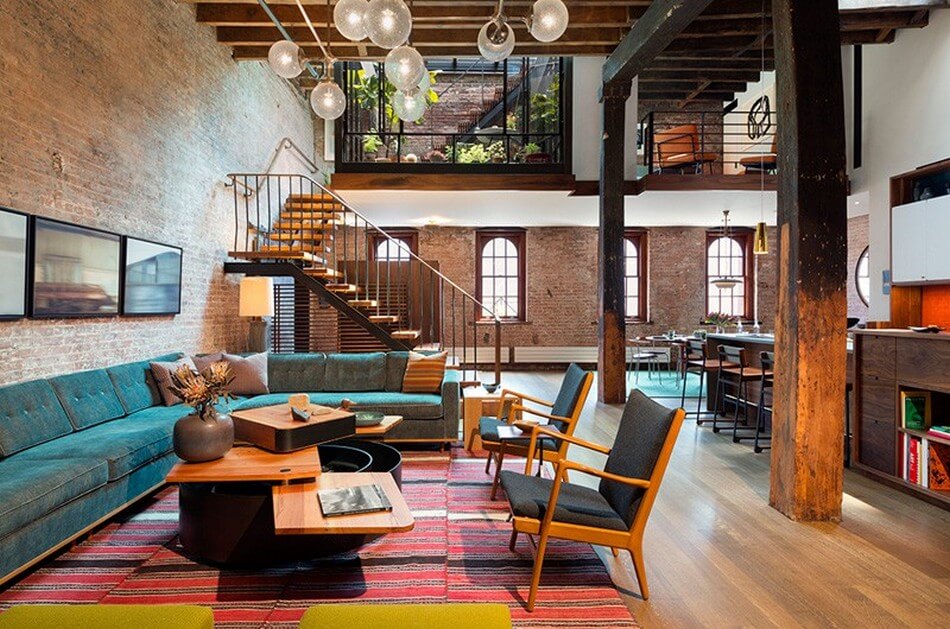
For the classical style, the use of plain wallpaper of noble shades is the most suitable solution. You can use wallpaper with large spectacular patterns. As for the ceiling, you can safely experiment using traditional methods of decoration, as well as large stucco molding or original stucco.
As this article has demonstrated, decorating the interior can be quite laborious, especially today, with the wide variety of materials to choose from. However, by studying the advantages and disadvantages of each individual component and making wise decisions with the design, you can easily create a cozy yet practical and long-lasting interior.


